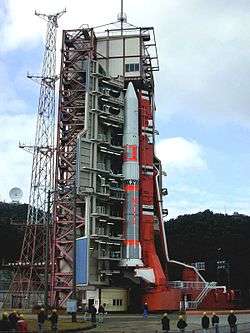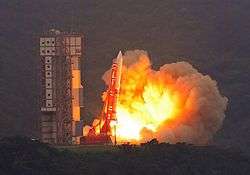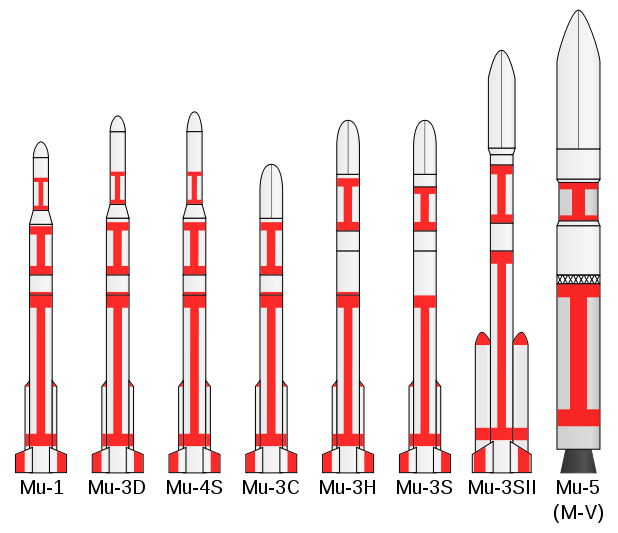Mu (rocket family)
The Mu, also known as M, was a series of Japanese solid-fuelled carrier rockets, which were launched from Uchinoura between 1966 and 2006. Originally developed by Japan's Institute of Space and Astronautical Science, Mu rockets were later operated by Japan Aerospace Exploration Agency following ISAS becoming part of it.[1]


Early Japanese carrier rockets
The first Mu rocket, the Mu-1 made a single, sub-orbital, test flight, on 31 October 1966. Subsequently, a series of rockets were produced, designated Mu-3 and Mu-4. In 1969 a suborbital test launch of the Mu-3D was conducted. The first orbital launch attempt for the Mu family, using a Mu-4S, was conducted on 25 September 1970, however the fourth stage did not ignite, and the rocket failed to reach orbit. On 16 February 1971, Tansei 1 was launched by another Mu-4S rocket. Two further Mu-4S launches took place during 1971 and 1972. The Mu-4S was replaced by the Mu-3C, was launched four times between 1974 and 1979, with three successes and one failure, and the Mu-3H, which was launched three times in 1977 and 1978. The Mu-3S was used between 1980 and 1984, making four launches. The final member of the Mu-3 family was the Mu-3SII, which was launched eight times between 1985 and 1995. The Mu-3 was replaced in service by the M-V.

M-V
The M-V, or Mu-5, was introduced in 1997 and retired in 2006. Seven launches, six of which were successful, were conducted. Typically, the M-V flew in a three-stage configuration, however a four-stage configuration, designated M-V KM was used 3 times, with the MUSES-B (HALCA) satellite in 1997, Nozomi (PLANET-B) spacecraft in 1998, and the Hayabusa (MUSES-C) spacecraft in 2003. The three-stage configuration had a maximum payload of 1,800 kg (4,000 lb) for an orbit with altitude of 200 km (120 mi) and inclination of 30°, and 1,300 kg (2,900 lb) to a polar orbit (90° inclination), with an altitude of 200 km (120 mi). The M-V KM could launch 1,800 kg (4,000 lb) to an orbit with 30° inclination and 400 km (250 mi) altitude.
The three stage M-V had a total launch mass of 137,500 kg (303,100 lb), whilst the total mass of a four-stage M-V KM was 139,000 kg (306,000 lb).
List of launches
All launches are from the Mu Launch Pad at the Uchinoura Space Center.
| Flight number | Date (UTC) | Payload | Orbit | Result | Remarks |
|---|---|---|---|---|---|
| M-4S-1 | September 25, 1970 05:00 |
MS-F1 | LEO (planned) | Failure | |
| M-4S-2 | February 16, 1971 04:00 |
MS-T1 (Tansei 1) | LEO | Success | |
| M-4S-3 | September 28, 1971 04:00 |
MS-F2 (Shinsei) | LEO | Success | |
| M-4S-4 | August 19, 1972 02:40 |
REXS (Denpa) | MEO | Success | |
| M-3C-1 | February 16, 1974 05:00 |
MS-T2 (Tansei 2) | MEO | Success | |
| M-3C-2 | February 24, 1975 05:25 |
SRATS (Taiyo) | MEO | Success | |
| M-3C-3 | February 4, 1976 05:00 |
CORSA | LEO (planned) | Failure | |
| M-3H-1 | February 19, 1977 05:15 |
MS-T3 (Tansei 3) | MEO | Success | |
| M-3H-2 | February 4, 1978 07:00 |
EXOS-A (Kyokko) | MEO | Success | |
| M-3H-3 | September 16, 1978 05:00 |
EXOS-B (Jikiken) | HEO | Success | |
| M-3C-4 | February 21, 1979 05:00 |
CORSA-b (Hakucho) | LEO | Success | |
| M-3S-1 | February 17, 1980 00:40 |
MS-T4 (Tansei 4) | LEO | Success | |
| M-3S-2 | February 21, 1981 00:30 |
ASTRO-A (Hinotori) | LEO | Success | |
| M-3S-3 | February 20, 1983 05:10 |
ASTRO-B (Tenma) | LEO | Success | |
| M-3S-4 | February 14, 1984 08:00 |
EXOS-C (Ohzora) | LEO | Success | |
| M-3SII-1 | January 7, 1985 19:26 |
MS-T5 (Sakigake) | HTO | Success | |
| M-3SII-2 | August 18, 1985 23:33 |
PLANET-A (Suisei) | HTO | Success | |
| M-3SII-3 | February 5, 1987 06:30 |
ASTRO-C (Ginga) | LEO | Success | |
| M-3SII-4 | February 21, 1989 23:30 |
EXOS-D (Akebono) | MEO | Success | |
| M-3SII-5 | January 24, 1990 11:46 |
MUSES-A (Hiten) | LTO | Success | |
| M-3SII-6 | August 30, 1991 02:30 |
SOLAR-A (Yohkoh) | LEO | Success | |
| M-3SII-7 | February 20, 1993 02:20 |
ASTRO-D/ASCA (Asuka) | LEO | Success | |
| M-3SII-8 | January 15, 1995 13:45 |
EXPRESS | LEO | Partial failure | |
| M-V-1 | February 12, 1997 04:50 |
MUSES-B/HALCA (Haruka) | HEO | Success | |
| M-V-3 | July 3, 1998 18:12 |
PLANET-B (Nozomi) | HTO | Success | |
| M-V-4 | February 10, 2000 01:30 |
ASTRO-E | LEO (planned) | Failure | |
| M-V-5 | May 9, 2003 04:29 |
MUSES-C (Hayabusa) | HTO | Success | |
| M-V-6 | July 10, 2005 03:30 |
ASTRO-EII (Suzaku) | LEO | Success | |
| M-V-8 | February 21, 2006 21:28 |
ASTRO-F (Akari) | LEO | Success | |
| M-V-7 | September 22, 2006 21:36 |
SOLAR-B (Hinode) | LEO | Success | |
^Note Two sub-orbital launches of the Mu family were performed prior to its first orbital flight: the 1.5 stage Mu-1 flew on October 31, 1966 at 05:04 UTC and the 3.5 stage Mu-3D flew on August 17, 1969 at 06:00 UTC.
See also
- Epsilon (rocket)
- J-I
- Comparison of orbital launchers families
- Comparison of orbital launch systems
References
- Pekkanen, Saadia; Kallender-Umezu, Paul (2010). In Defense of Japan: From the Market to the Military in Space Policy. Stanford University Press. ISBN 9780804775007.
External links
| Wikimedia Commons has media related to M (rocket). |